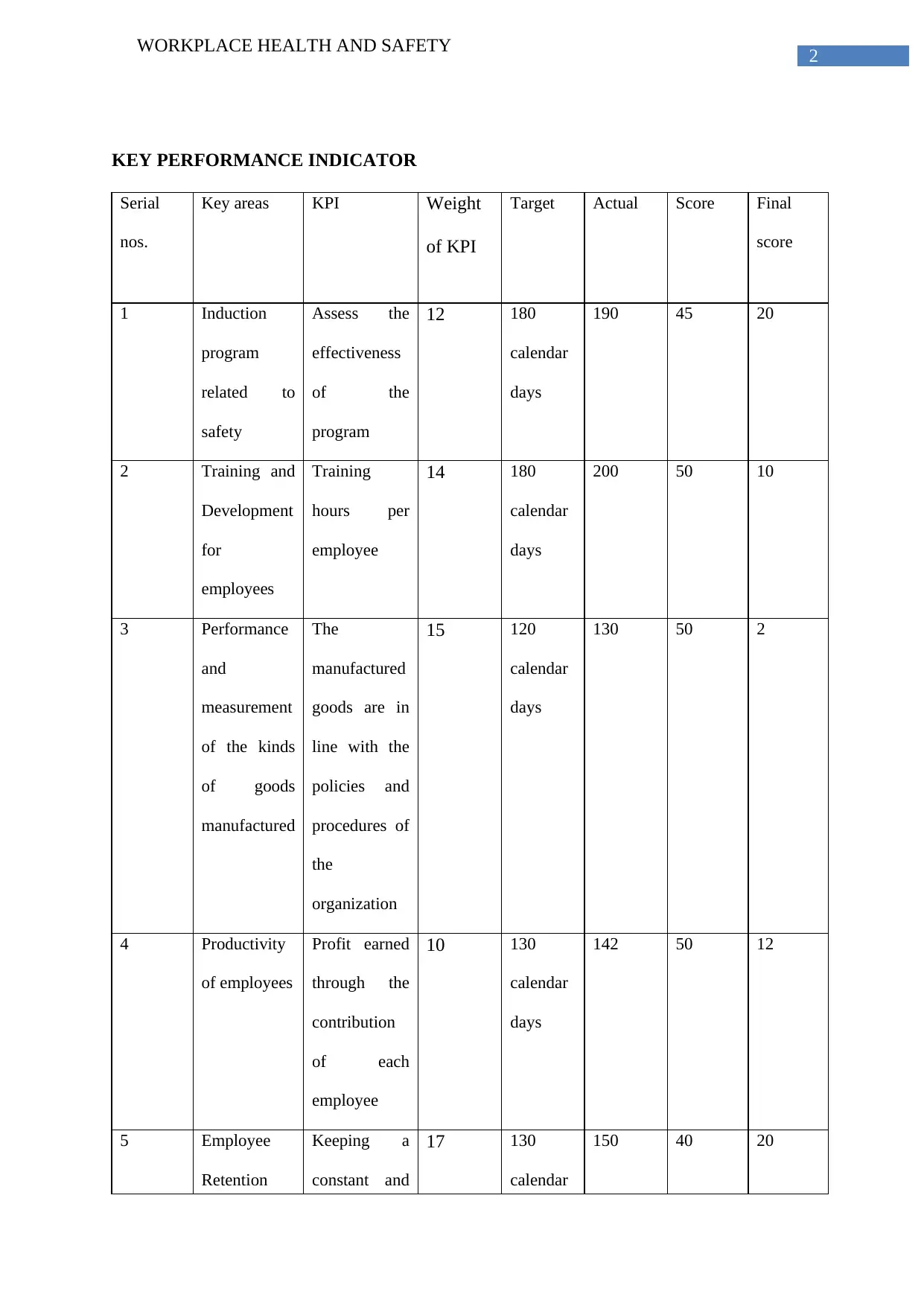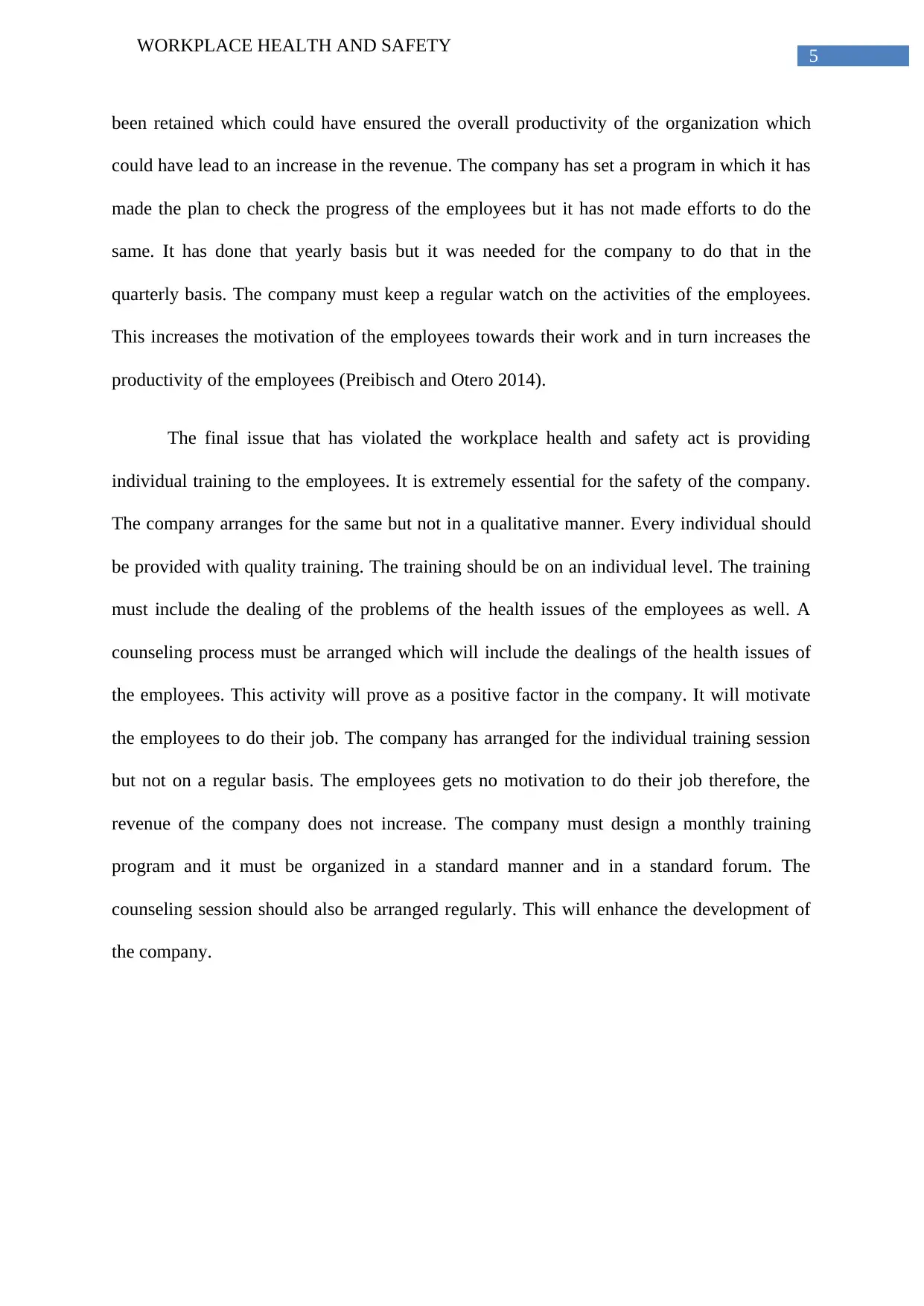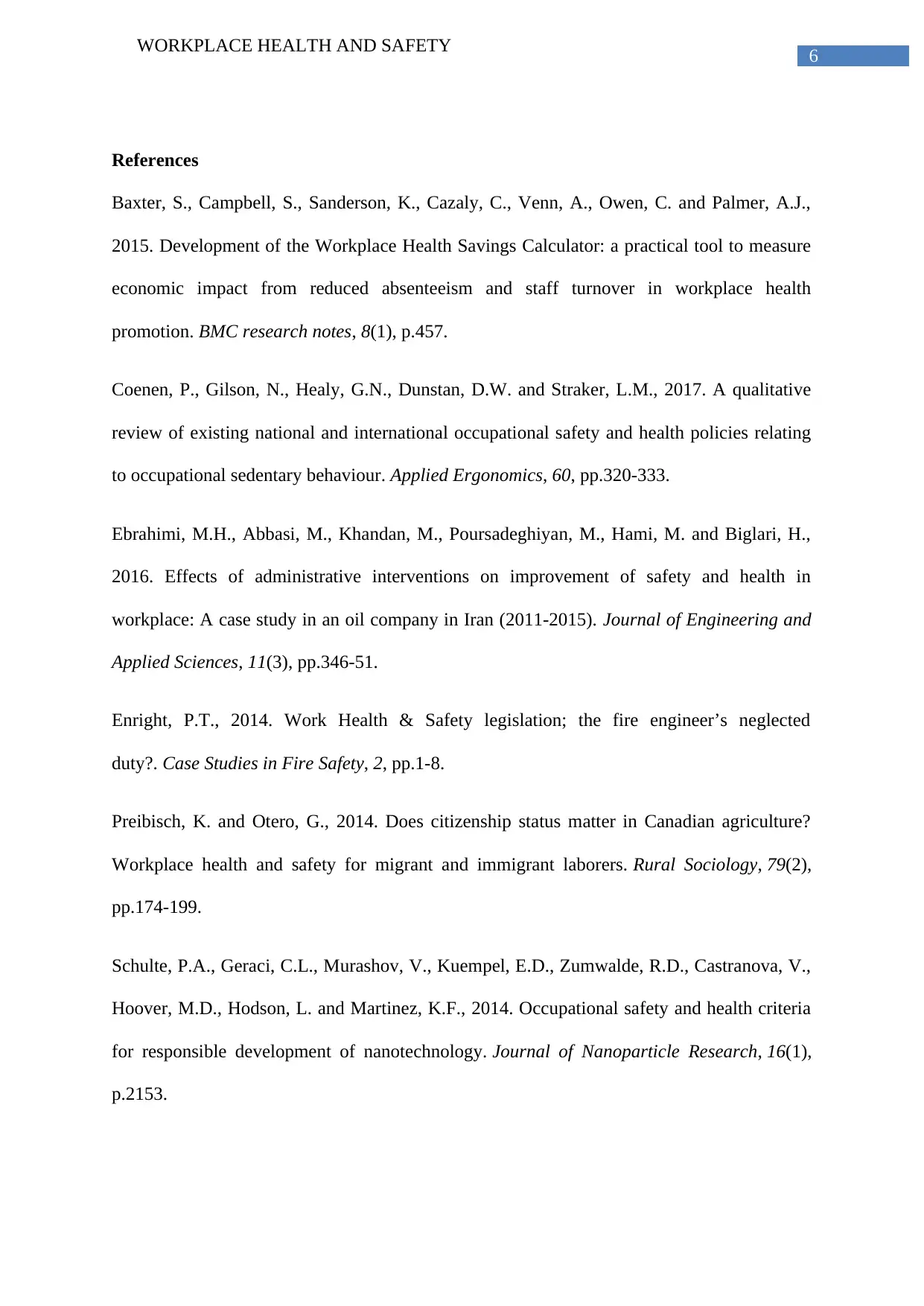University Workplace Health and Safety: KPI Analysis Report
VerifiedAdded on 2020/05/04
|7
|1503
|69
Report
AI Summary
This report analyzes workplace health and safety, focusing on key performance indicators (KPIs) within a car manufacturing company. It examines areas such as induction programs, employee training and development, performance measurement of manufactured goods, employee productivity, and employee retention. The report evaluates the effectiveness of the company's strategies, highlighting gaps in areas like the induction process, employee monitoring, and individual training programs. It provides recommendations for improvement, emphasizing the importance of employee awareness, regular performance evaluations, and quality training sessions to ensure compliance with workplace health and safety regulations and enhance overall organizational performance. The report also references various academic sources to support its findings and recommendations.

Running head: WORKPLACE HEALTH AND SAFETY
Workplace health and safety
Name of the student
Name of the university
Author note
Workplace health and safety
Name of the student
Name of the university
Author note
Paraphrase This Document
Need a fresh take? Get an instant paraphrase of this document with our AI Paraphraser

2
WORKPLACE HEALTH AND SAFETY
KEY PERFORMANCE INDICATOR
Serial
nos.
Key areas KPI Weight
of KPI
Target Actual Score Final
score
1 Induction
program
related to
safety
Assess the
effectiveness
of the
program
12 180
calendar
days
190 45 20
2 Training and
Development
for
employees
Training
hours per
employee
14 180
calendar
days
200 50 10
3 Performance
and
measurement
of the kinds
of goods
manufactured
The
manufactured
goods are in
line with the
policies and
procedures of
the
organization
15 120
calendar
days
130 50 2
4 Productivity
of employees
Profit earned
through the
contribution
of each
employee
10 130
calendar
days
142 50 12
5 Employee
Retention
Keeping a
constant and
17 130
calendar
150 40 20
WORKPLACE HEALTH AND SAFETY
KEY PERFORMANCE INDICATOR
Serial
nos.
Key areas KPI Weight
of KPI
Target Actual Score Final
score
1 Induction
program
related to
safety
Assess the
effectiveness
of the
program
12 180
calendar
days
190 45 20
2 Training and
Development
for
employees
Training
hours per
employee
14 180
calendar
days
200 50 10
3 Performance
and
measurement
of the kinds
of goods
manufactured
The
manufactured
goods are in
line with the
policies and
procedures of
the
organization
15 120
calendar
days
130 50 2
4 Productivity
of employees
Profit earned
through the
contribution
of each
employee
10 130
calendar
days
142 50 12
5 Employee
Retention
Keeping a
constant and
17 130
calendar
150 40 20

3
WORKPLACE HEALTH AND SAFETY
routine watch
on the
performance
of the
employees.
days
From the above diagram this can be commented that the key indicator factors play a
major role in any working organization. The company named Wollongong car manufacturing
maintained certain key indicator factors that were necessary in the company. The company
had a detailed plan of the key indicator factors. The above table shows the same. The key
areas include the induction program that is safe for the employees, the individual training
program for each employee, the performance and the measurement of the kinds of goods
manufactured (Baxter et al. 2015). This is essentially important and it includes the
measurement of the performance of the employees and the knowledge regarding the gods that
are being manufactured in the company. It evaluates whether the manufactured goods are in
line with the procedures and most importantly the policies of the company. The next key
factor is the productivity of the employees. The major reason behind keeping this factor is to
check the productivity of the employees (Ebrahimi et al. 2016). The employees are supposed
to give their full production. They are supposed to give the maximum amount of production
through the execution of maximum efforts. This factor is maintained to increase the
productivity of the employees and increase the revenue of the products. The final key factor
of this is the retention of the employees (Tompa et al. 2016). The KPI of this area is to keep a
regular watch on the employees. It is framed to rather keep a check on the activities and the
potential of the employees working in the company (Schulte et al. 2014). According to the
report the target of attaining these key factors is not set and the respective targets are set for
WORKPLACE HEALTH AND SAFETY
routine watch
on the
performance
of the
employees.
days
From the above diagram this can be commented that the key indicator factors play a
major role in any working organization. The company named Wollongong car manufacturing
maintained certain key indicator factors that were necessary in the company. The company
had a detailed plan of the key indicator factors. The above table shows the same. The key
areas include the induction program that is safe for the employees, the individual training
program for each employee, the performance and the measurement of the kinds of goods
manufactured (Baxter et al. 2015). This is essentially important and it includes the
measurement of the performance of the employees and the knowledge regarding the gods that
are being manufactured in the company. It evaluates whether the manufactured goods are in
line with the procedures and most importantly the policies of the company. The next key
factor is the productivity of the employees. The major reason behind keeping this factor is to
check the productivity of the employees (Ebrahimi et al. 2016). The employees are supposed
to give their full production. They are supposed to give the maximum amount of production
through the execution of maximum efforts. This factor is maintained to increase the
productivity of the employees and increase the revenue of the products. The final key factor
of this is the retention of the employees (Tompa et al. 2016). The KPI of this area is to keep a
regular watch on the employees. It is framed to rather keep a check on the activities and the
potential of the employees working in the company (Schulte et al. 2014). According to the
report the target of attaining these key factors is not set and the respective targets are set for
⊘ This is a preview!⊘
Do you want full access?
Subscribe today to unlock all pages.

Trusted by 1+ million students worldwide

4
WORKPLACE HEALTH AND SAFETY
the same. It has been observed that the company has attained the target within the time in
maximum times. The company has set a goal target through the key performance indicator
model and they have to some extent has not justified that. The final score of the target
achieved has shown the same. The function of key performance indicators is to measure the
effectiveness of the set plans and procedures formulated by the officials of the company and
keep a track of whether the performance of the employees are in line with the rules and
responsibilities assigned to them to achieve the desired target. The Wollongong
manufacturing aims for the same and has set up this model for the attainment of the same
(Coenen et al. 2017).
Recommendations for improvements
According to the Workplace health and safety act the there has been a gap in the
Wollongong manufacturing company. The gaps are the lack of understanding of the
manufacturing company and the trainings in the company that is to be used or that could be
expected to be used by the investors. The investors must follow the structure could e
reasonably used by the investors.
The first and foremost gap is the induction process which is maintained for the safety
of the employees in the company is not maintained. The employees were not fully aware of
their jobs and responsibilities which created a threat to the safety of the company as it might
lead to health hazard. The target that was set was attained in the right time but that was just
the job done on the part of the company. The company should take proper feedback from the
employees regarding their understanding of the induction process. This is necessary and
highly essential in the company (Enright 2014).
The second gap was the failure in keeping a regular watch on the activities and
performance of the employees through which talented and efficient employees could have
WORKPLACE HEALTH AND SAFETY
the same. It has been observed that the company has attained the target within the time in
maximum times. The company has set a goal target through the key performance indicator
model and they have to some extent has not justified that. The final score of the target
achieved has shown the same. The function of key performance indicators is to measure the
effectiveness of the set plans and procedures formulated by the officials of the company and
keep a track of whether the performance of the employees are in line with the rules and
responsibilities assigned to them to achieve the desired target. The Wollongong
manufacturing aims for the same and has set up this model for the attainment of the same
(Coenen et al. 2017).
Recommendations for improvements
According to the Workplace health and safety act the there has been a gap in the
Wollongong manufacturing company. The gaps are the lack of understanding of the
manufacturing company and the trainings in the company that is to be used or that could be
expected to be used by the investors. The investors must follow the structure could e
reasonably used by the investors.
The first and foremost gap is the induction process which is maintained for the safety
of the employees in the company is not maintained. The employees were not fully aware of
their jobs and responsibilities which created a threat to the safety of the company as it might
lead to health hazard. The target that was set was attained in the right time but that was just
the job done on the part of the company. The company should take proper feedback from the
employees regarding their understanding of the induction process. This is necessary and
highly essential in the company (Enright 2014).
The second gap was the failure in keeping a regular watch on the activities and
performance of the employees through which talented and efficient employees could have
Paraphrase This Document
Need a fresh take? Get an instant paraphrase of this document with our AI Paraphraser

5
WORKPLACE HEALTH AND SAFETY
been retained which could have ensured the overall productivity of the organization which
could have lead to an increase in the revenue. The company has set a program in which it has
made the plan to check the progress of the employees but it has not made efforts to do the
same. It has done that yearly basis but it was needed for the company to do that in the
quarterly basis. The company must keep a regular watch on the activities of the employees.
This increases the motivation of the employees towards their work and in turn increases the
productivity of the employees (Preibisch and Otero 2014).
The final issue that has violated the workplace health and safety act is providing
individual training to the employees. It is extremely essential for the safety of the company.
The company arranges for the same but not in a qualitative manner. Every individual should
be provided with quality training. The training should be on an individual level. The training
must include the dealing of the problems of the health issues of the employees as well. A
counseling process must be arranged which will include the dealings of the health issues of
the employees. This activity will prove as a positive factor in the company. It will motivate
the employees to do their job. The company has arranged for the individual training session
but not on a regular basis. The employees gets no motivation to do their job therefore, the
revenue of the company does not increase. The company must design a monthly training
program and it must be organized in a standard manner and in a standard forum. The
counseling session should also be arranged regularly. This will enhance the development of
the company.
WORKPLACE HEALTH AND SAFETY
been retained which could have ensured the overall productivity of the organization which
could have lead to an increase in the revenue. The company has set a program in which it has
made the plan to check the progress of the employees but it has not made efforts to do the
same. It has done that yearly basis but it was needed for the company to do that in the
quarterly basis. The company must keep a regular watch on the activities of the employees.
This increases the motivation of the employees towards their work and in turn increases the
productivity of the employees (Preibisch and Otero 2014).
The final issue that has violated the workplace health and safety act is providing
individual training to the employees. It is extremely essential for the safety of the company.
The company arranges for the same but not in a qualitative manner. Every individual should
be provided with quality training. The training should be on an individual level. The training
must include the dealing of the problems of the health issues of the employees as well. A
counseling process must be arranged which will include the dealings of the health issues of
the employees. This activity will prove as a positive factor in the company. It will motivate
the employees to do their job. The company has arranged for the individual training session
but not on a regular basis. The employees gets no motivation to do their job therefore, the
revenue of the company does not increase. The company must design a monthly training
program and it must be organized in a standard manner and in a standard forum. The
counseling session should also be arranged regularly. This will enhance the development of
the company.

6
WORKPLACE HEALTH AND SAFETY
References
Baxter, S., Campbell, S., Sanderson, K., Cazaly, C., Venn, A., Owen, C. and Palmer, A.J.,
2015. Development of the Workplace Health Savings Calculator: a practical tool to measure
economic impact from reduced absenteeism and staff turnover in workplace health
promotion. BMC research notes, 8(1), p.457.
Coenen, P., Gilson, N., Healy, G.N., Dunstan, D.W. and Straker, L.M., 2017. A qualitative
review of existing national and international occupational safety and health policies relating
to occupational sedentary behaviour. Applied Ergonomics, 60, pp.320-333.
Ebrahimi, M.H., Abbasi, M., Khandan, M., Poursadeghiyan, M., Hami, M. and Biglari, H.,
2016. Effects of administrative interventions on improvement of safety and health in
workplace: A case study in an oil company in Iran (2011-2015). Journal of Engineering and
Applied Sciences, 11(3), pp.346-51.
Enright, P.T., 2014. Work Health & Safety legislation; the fire engineer’s neglected
duty?. Case Studies in Fire Safety, 2, pp.1-8.
Preibisch, K. and Otero, G., 2014. Does citizenship status matter in Canadian agriculture?
Workplace health and safety for migrant and immigrant laborers. Rural Sociology, 79(2),
pp.174-199.
Schulte, P.A., Geraci, C.L., Murashov, V., Kuempel, E.D., Zumwalde, R.D., Castranova, V.,
Hoover, M.D., Hodson, L. and Martinez, K.F., 2014. Occupational safety and health criteria
for responsible development of nanotechnology. Journal of Nanoparticle Research, 16(1),
p.2153.
WORKPLACE HEALTH AND SAFETY
References
Baxter, S., Campbell, S., Sanderson, K., Cazaly, C., Venn, A., Owen, C. and Palmer, A.J.,
2015. Development of the Workplace Health Savings Calculator: a practical tool to measure
economic impact from reduced absenteeism and staff turnover in workplace health
promotion. BMC research notes, 8(1), p.457.
Coenen, P., Gilson, N., Healy, G.N., Dunstan, D.W. and Straker, L.M., 2017. A qualitative
review of existing national and international occupational safety and health policies relating
to occupational sedentary behaviour. Applied Ergonomics, 60, pp.320-333.
Ebrahimi, M.H., Abbasi, M., Khandan, M., Poursadeghiyan, M., Hami, M. and Biglari, H.,
2016. Effects of administrative interventions on improvement of safety and health in
workplace: A case study in an oil company in Iran (2011-2015). Journal of Engineering and
Applied Sciences, 11(3), pp.346-51.
Enright, P.T., 2014. Work Health & Safety legislation; the fire engineer’s neglected
duty?. Case Studies in Fire Safety, 2, pp.1-8.
Preibisch, K. and Otero, G., 2014. Does citizenship status matter in Canadian agriculture?
Workplace health and safety for migrant and immigrant laborers. Rural Sociology, 79(2),
pp.174-199.
Schulte, P.A., Geraci, C.L., Murashov, V., Kuempel, E.D., Zumwalde, R.D., Castranova, V.,
Hoover, M.D., Hodson, L. and Martinez, K.F., 2014. Occupational safety and health criteria
for responsible development of nanotechnology. Journal of Nanoparticle Research, 16(1),
p.2153.
⊘ This is a preview!⊘
Do you want full access?
Subscribe today to unlock all pages.

Trusted by 1+ million students worldwide

7
WORKPLACE HEALTH AND SAFETY
Tompa, E., Kalcevich, C., Foley, M., McLeod, C., Hogg‐Johnson, S., Cullen, K.,
MacEachen, E., Mahood, Q. and Irvin, E., 2016. A systematic literature review of the
effectiveness of occupational health and safety regulatory enforcement. American journal of
industrial medicine, 59(11), pp.919-933.
WORKPLACE HEALTH AND SAFETY
Tompa, E., Kalcevich, C., Foley, M., McLeod, C., Hogg‐Johnson, S., Cullen, K.,
MacEachen, E., Mahood, Q. and Irvin, E., 2016. A systematic literature review of the
effectiveness of occupational health and safety regulatory enforcement. American journal of
industrial medicine, 59(11), pp.919-933.
1 out of 7
Related Documents
Your All-in-One AI-Powered Toolkit for Academic Success.
+13062052269
info@desklib.com
Available 24*7 on WhatsApp / Email
![[object Object]](/_next/static/media/star-bottom.7253800d.svg)
Unlock your academic potential
Copyright © 2020–2025 A2Z Services. All Rights Reserved. Developed and managed by ZUCOL.




